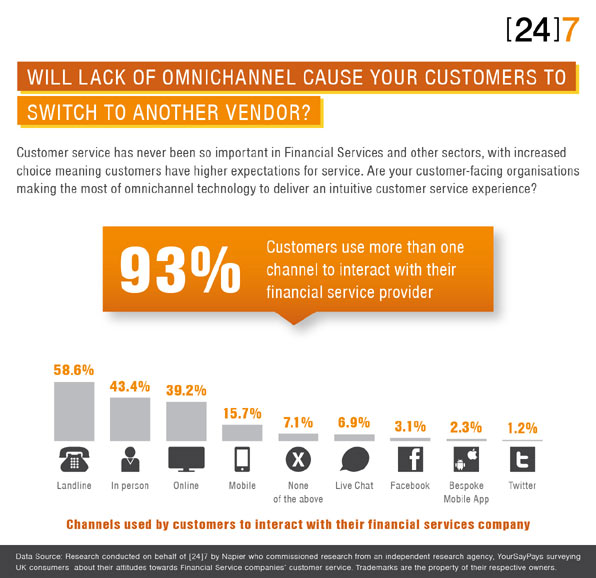Top Stories
How social media is igniting a revolution in customer service

By Mike Hughes, European MD at [24]7, the intuitive customer experience company

We mostly hear about social media in the context of FS customer service when something goes wrong. People use social media – mostly Twitter and Facebook – to call out bad service they have received from their bank or insurer and just occasionally, to recognise good service.
Used for this purpose, social media is an effective customer service tool. What it rarely offers though, is actual resolution to a customer service query. Customer service conversations in social sites will usually be redirected to traditional channels where customer history and data is required and used to address the issue in question.
Consumers only turn to social media because other customer service channels have failed them and on the whole would rather not have these conversations in public.
Financial services customer service
This is certainly true when one focuses on financial services customer service specifically. [24]7 recently commissioned research with more than 2,000 UK consumers into their FS customer service likes and dislikes and found that a majority of respondents would prefer to resolve issues with their FS provider in private. In fact, social media was the least preferred way of interacting with an FS provider, with only 3.1 per cent of consumers using Facebook and 1.2 per cent using Twitter to do so.
The most popular methods of interacting with FS institutions remain in-person and over the phone. Just two per cent of people use their FS provider’s mobile apps for customer service, despite a number of FS providers offering this as an option. The volume of people using social media for customer service did rise amongst the younger generations but social media remained the least favoured option for all age groups.
I believe the reasons for this are two-fold. Firstly, there is still a tendency to regard financial matters as private. Social media platforms are public and people are not comfortable with discussing aspects of their personal financial situation in such a way and will only do so as a last resort when other avenues have failed.
Secondly, the nature of social media does not really lend itself to effective customer service resolution. When people log-on to Facebook, Twitter, Google+ or other social networks, they are looking to explore, to engage, to share, to learn and to communicate with friends, family, colleagues and even strangers. Making a complaint to a financial services provider is not a priority for most social network users.
The real value of social media for customer service
So whilst social media is neither especially suitable nor effective for actually resolving customer service issues, virtually every FS firm will have a social media presence for customer service. How can they use that to get true value?
Social media has the potential to ignite a revolution in FS customer service, but it needs to be deployed in the right way. Organisations should be using social media as part of an overall omnichannel experience, ensuring that customer context is maintained as consumers go from channel to channel. Our research revealed that 93 per cent of consumers now regularly use more than one channel when interacting with their FS provider’s customer service, so ensuring that consumers get the same quality of customer service, irrespective of channel grows ever more important.
The research also showed that the biggest frustration in FS customer service was providers not knowing who consumers are or why they were engaging customer service, despite having interacted previously via another channel. This is addressed by making more effective use of customers’ big data, content mined from every Tweet and Facebook interaction, as well as CRM data on billing history, past purchases, and loyalty programs; location data from smartphone or tablet apps; click-stream and web behaviour data from web analytics software; and chat and voice interaction transcripts from contact centres.
Analysis of this data allows an organisation to understand their customers better and to offer them a predictive customer service, based on both previous interactions and likely future requirements, and social media can play an integral role in generating such data.
Don’t risk getting customer service wrong
More than a quarter of respondents in our research admitted that they had considered leaving their bank or insurer because of bad customer service they had received, so organisations must adapt quickly to the changing customer service requirements. Social media has enormous potential for customer service, in financial services and other industries. It can be used as a platform for customers to let off steam, get their issue noticed and get it resolved via another channel. Buts its true value lays elsewhere, as part of an overall omnichannel experience and as part of the big data that is used by predictive analytics to determine what consumers really want.
From this, customers get better service and the business can capture, manage and analyse customer feedback to make business improvements that will enhance long-term performance, customer sentiment and reduce complaints.

-
Top Stories3 days ago
After VW plant victory, UAW sets its sights on Mercedes in Alabama
-
Business2 days ago
Mike Bahun and Fundraising University Make a Lasting Impact on Sports Programs Nationwide
-
Investing2 days ago
Forex Market Trends to Watch Out For in 2024
-
Top Stories3 days ago
Hedge fund borrowing hits five-year peak, Goldman Sachs says








